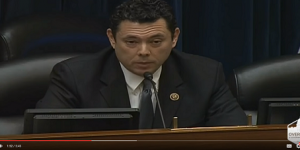More on Sanctuary Cities and the report from The Center from Immigration Studies we reported on earlier this week: Rejecting Detainers, Endangering Communities: Sanctuaries release thousands of criminals
State and local sanctuary policies caused the release of more than 8,000 criminal alien offenders sought by ICE for deportation in 276 jurisdictions around the country over an eight-month period, according to ICE records obtained by the Center for Immigration Studies in a FOIA request. Sixty-three percent of the individuals freed by local authorities had prior criminal histories or were labeled a public safety concern at the time of their release. Nearly 1,900 of the released offenders subsequently were arrested for another crime within that eight-month period. ICE arrested approximately 750 of the recidivists, but just over 1,000 (60 percent) remained at large.
276 Jurisdictions Had Sanctuary Policies. According to the report, as of last year, there were 276 state and local jurisdictions that had adopted policies of non-compliance with some or all ICE detainers. These policies took the form of policies, laws, executive orders, or regulations. These jurisdictions were located in 43 states and the District of Columbia. (See map here.)
What Is a Detainer? A detainer is the primary tool used by ICE to take custody of criminal aliens for deportation. It is a notice to another law enforcement agency that ICE intends to assume custody of an alien, and it includes information on the alien’s previous criminal history, immigration violations, and potential risk to public safety or security.
Number of Detainers Refused. From January 1, 2014, to August 31, 2014, local law enforcement agencies refused to comply with a total of 8,811 detainers, resulting in aliens being released from custody. These detainers were associated with 8,145 individuals, of whom:
- 7,600 had one declined detainer;
- 464 had two declined detainers; and
- 81 had three or more declined detainers.
As of June 2015, the total number of detainers rejected by local sanctuary jurisdictions reportedly had grown to more than 17,000.
Most Offenders Released Had Prior Arrests; One-Fourth Were Already Felons. The majority (63 percent) of the individuals freed by local agencies had serious prior criminal records.
- 5,132 were previously convicted or charged with a crime or were labeled a public safety concern. Of these,
- 2,984 had a prior felony conviction or charge;
- 1,909 had a prior misdemeanor conviction or charge related to violence, assault, sexual abuse, DUI, weapons, or drug distribution or trafficking; and
- 239 had three or more other misdemeanor convictions.
The report does not state how many of the released offenders had prior single misdemeanors or other types of violations not directly associated with violence, assault, or drugs.
1,900 Released Offenders Were Later Arrested 4,300 Times; Most Are Apparently Still at Large, even after Re-Offending. Of the 8,145 individual aliens freed by local agencies, there were 1,867 (23 percent) who were subsequently arrested again for a criminal offense.
- ICE took action (arrest or removal) against 40 percent (751) of the 1,867 who re-offended.
- 1,116 (60 percent) of the re-offenders were at large at the time of the study.
Crimes Committed after Release by Sanctuaries. The 1,867 offenders who were released and subsequently re-offended were arrested 4,298 times during the eight-month period covered by the study. They accumulated 7,491 new charges in total, after their release. Ten percent of the new charges involved dangerous drugs and seven percent were for driving under the influence of alcohol (DUI).
The report describes six instances of very serious crimes committed by criminal alien felons who were sought by ICE with a detainer, but nevertheless released by a local law enforcement agency with sanctuary policies:
- Santa Clara County, Calif.: On April 14, 2014, an individual with nine previous convictions (including seven felonies) and a prior removal was arrested for “first degree burglary” and “felony resisting an officer causing death or significant bodily injury”. Following release, the individual was arrested for a controlled substance crime.
- Los Angeles, Calif.: On April 6, 2014, an alien was arrested for “felony continuous sexual abuse of a child”. After release, the alien was arrested for “felony sodomy of a victim under 10 years old”.
- San Francisco, Calif.: On March 19, 2014, an illegal alien with two prior deportations was arrested for “felony second degree robbery, felony conspiracy to commit a crime, and felony possession of a narcotic controlled substance”, After release, the alien was again arrested for “felony rape with force or fear”, “felony sexual penetration with force”, “felony false imprisonment”, witness intimidation, and other charges.
- San Mateo County, Calif.: On February 16, 2014, an individual was arrested for “felony lewd or lascivious acts with a child under 14”. In addition, the alien had a prior DUI conviction. Following release by the local agency, the individual was arrested for three counts of “felony oral copulation with a victim under 10” and two counts of “felony lewd or lascivious acts with a child under 14”.
- Miami Beach, Fla.: On December 19, 2013, the police department arrested an alien for felony grand theft. This alien had been ordered removed (and presumably absconded) in 2009. The alien also had prior convictions for strong-arm robbery, cocaine possession, larceny, trespassing, theft, marijuana possession, and resisting an officer. After release by the local agency, the alien was arrested on two separate occasions; once for “aggravated assault with a weapon and larceny” and once for “under the influence of a controlled substance”.
- Santa Clara County, Calif.: On November 7, 2013, an alien was arrested (and later convicted) for “felony grand theft and felony dealing with stolen property”. This alien had been ordered removed in 2010 (again, a likely absconder). The alien also had prior felony and misdemeanor convictions for narcotic possession, theft, receiving stolen property, illegal entry, and other crimes. After release by local authorities, the alien was arrested for “felony resisting an officer causing death or severe bodily injury” and “felony first degree burglary”.
Which Jurisdictions Are Sanctuaries? As of the date of the report, 276 counties in 43 states had refused to comply with an ICE detainer. The largest number of detainers were refused in the following jurisdictions:
- Santa Clara County, Calif.
- Los Angeles County, Calif.
- Alameda County, Calif.
- San Diego County, Calif.
- Miami-Dade County, Fla.
The ICE report included a list of the 20 detention facilities that had housed the inmates that were freed, but it was redacted from the document. The report states that the following jails were among the top 20:
- Santa Clara County Jail in San Jose, Calif.
- Santa Rita Jail in Dublin, Calif.
- Twin Towers Correctional Facility in Los Angeles, Calif.
- Dade Correctional Institution in Miami, Fla.
- Vista Detention Facility in San Diego, Calif.
Conclusion. Local refusal to comply with ICE detainers has become a public safety problem in many communities, and a mission crisis for ICE that demands immediate attention.
When a law enforcement agency decides to release a criminal offender that ICE is seeking to deport, it must take moral, and possibly legal, responsibility for the consequences. Even if the agency believes that it faces legal liability if it complies with a detainer, or if local or state laws forbid compliance, the agency still can communicate with ICE by phone, email, or other means to coordinate a custody transfer that does not require a detainer to be executed. So no sheriff or police department is “forced” to release criminal aliens who would otherwise be taken by ICE.
One way to address this problem is for state governments to pass legislation or issue legal opinions clarifying that law enforcement agencies are authorized and expected to comply with all ICE detainers or make other arrangements with ICE for the transfer of inmates on the path to deportation.
Many believe that the federal government has grounds to sue San Francisco in federal court for obstructing its work. That’s a good idea in theory, but the Obama administration has made it clear that it will assert federal supremacy in immigration matters only when the states like Arizona are trying to help enforce the laws, not when states like California try to block enforcement.
Moreover, the Obama administration has given sanctuaries free rein to ignore detainers by ending the successful Secure Communities program and replacing it with the Priority Enforcement Program. This new program explicitly allows local agencies to disregard ICE notifications of deportable aliens in their custody by replacing detainers with “requests for notification”.
The only truly effective and lasting solution is for Congress to spell out in federal law that local law enforcement agencies must cooperate with ICE by complying with all detainers and responding to all notifications or face sanctions in the form of disqualification from certain kinds of federal funding. Such a provision has been included in the Davis-Oliver Act, introduced by Rep. Trey Gowdy (R-S.C.) and Sen. Jeff Sessions (R-Ala.), and named in honor of two deputies who were killed last year by a previously deported illegal alien cartel operative in California.
The Davis-Oliver Act has earned the endorsement of the National Sheriffs’ Association as well as many individual sheriffs and police chiefs, indicating that sanctuary policies are well out of the mainstream of law-enforcement practice in America. Congress — and the presidential candidates — should join the sheriffs’ association in working for a new approach that will keep the list of victims from growing.
Map: Sanctuary Cities, Counties and States
is an independent, non-partisan, non-profit, research organization. Since their founding in 1985, they have pursued a single mission – providing immigration policymakers, the academic community, news media, and concerned citizens with reliable information about the social, economic, environmental, security, and fiscal consequences of legal and illegal immigration into the United States.





























